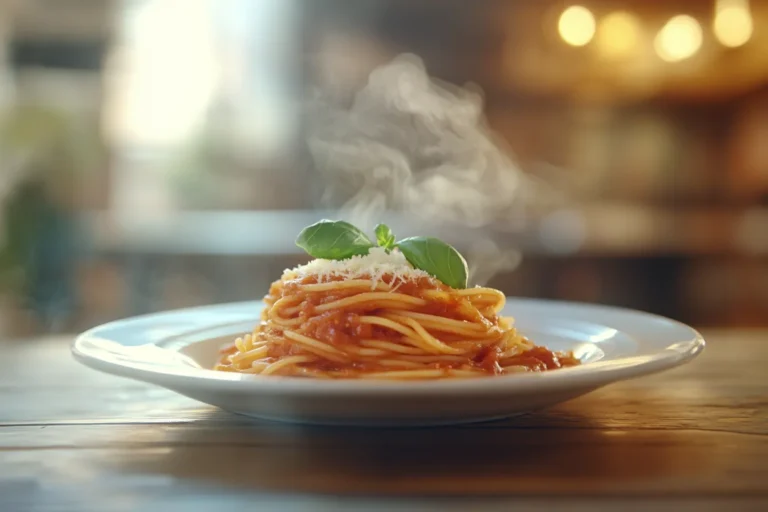There’s nothing quite like a plate of spaghetti with homemade tomato sauce—it’s comforting, flavorful, and surprisingly simple to make. Unlike store-bought sauces, a homemade tomato sauce bursts with fresh flavors, rich textures, and a personal touch. Whether you’re a home cook looking for a foolproof recipe or a pasta lover wanting to perfect this classic dish, you’re in the right place.
In this guide, we’ll walk you through everything from choosing the best tomatoes to cooking spaghetti to perfection. We’ll also explore seasoning techniques, variations, and pro tips to take your homemade tomato pasta to the next level. By the end, you’ll be whipping up a sauce so good, you’ll never go back to jarred versions again!
Now, let’s start with the basics—why homemade tomato sauce is worth the effort.
Introduction to Spaghetti with Homemade Tomato
What Makes Homemade Tomato Sauce Special?
Why go through the trouble of making your own tomato sauce when you can grab a jar from the store? The answer is simple—flavor and freshness! Homemade sauce uses real ingredients, free from preservatives, artificial flavors, or excess sugar. The taste? Unmatched.
When you simmer fresh tomatoes with garlic, olive oil, and herbs, their natural sweetness intensifies, creating a deep, rich sauce. Plus, you control the texture—smooth and velvety or chunky and rustic, it’s all up to you.
Why Spaghetti Pairs Perfectly with Tomato Sauce
Spaghetti is the ultimate pasta for a homemade tomato sauce. Its long, thin strands are perfect for capturing every drop of rich, tangy goodness. Unlike thicker pastas, spaghetti provides the perfect balance—it holds onto the sauce without overpowering its delicate flavors.
Another reason this pairing works so well is the simplicity. You don’t need fancy ingredients or complicated techniques. A handful of fresh tomatoes, a good olive oil, and properly cooked spaghetti—perfection in a bowl.
Quick Overview of the Recipe
Making spaghetti with homemade tomato sauce is easier than you might think. Here’s a quick rundown of the process:
- Pick the best tomatoes – Fresh, ripe, and juicy tomatoes are key.
- Prepare the sauce – Simmer tomatoes with garlic, olive oil, and seasonings.
- Cook the spaghetti – Boil it to a perfect al dente texture.
- Combine & serve – Toss the pasta with your flavorful homemade sauce.
That’s it! In the next section, we’ll break down the ingredients you need to create the perfect homemade tomato pasta dish. Stay tuned! 🍝
Ingredients for the Perfect Homemade Tomato Sauce
Choosing the Right Tomatoes: Fresh vs. Canned
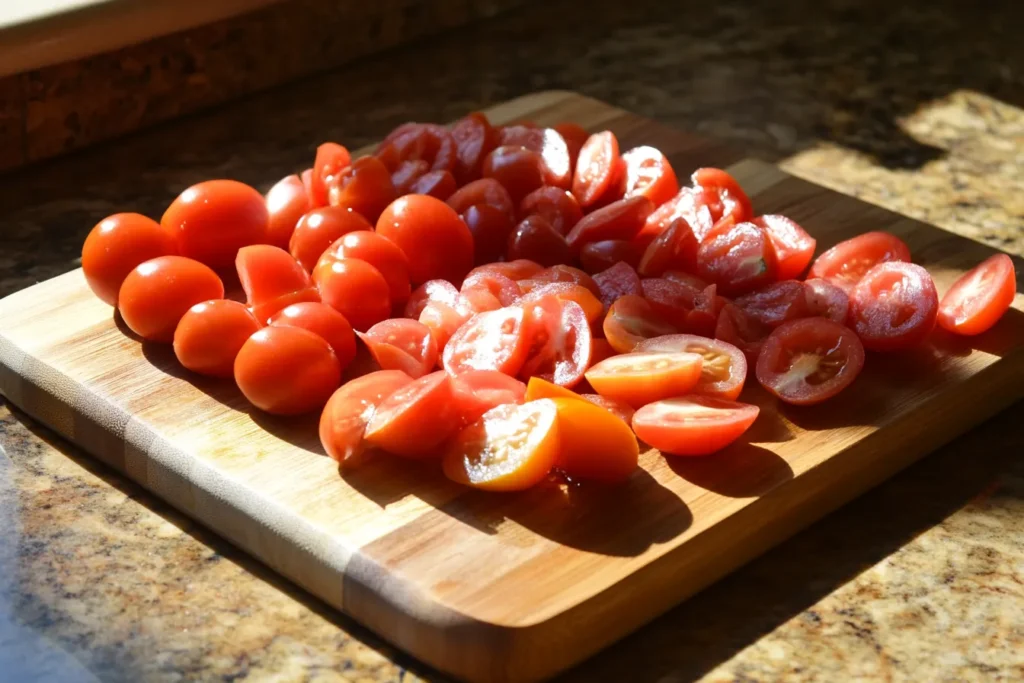
The foundation of any great spaghetti with homemade tomato sauce lies in the tomatoes you choose. Should you go fresh or canned? Well, it depends.
- Fresh Tomatoes: If they’re in season, ripe, and bursting with sweetness, fresh tomatoes will give your sauce a light, vibrant taste. Opt for Roma, San Marzano, or heirloom varieties for the best results.
- Canned Tomatoes: When fresh ones aren’t at their peak, high-quality canned tomatoes (especially San Marzano) work wonders. They’re already peeled and packed in rich tomato juice, making sauce-making a breeze.
For a deep, authentic Italian flavor, try blending both fresh and canned tomatoes. This mix balances brightness with a robust, slow-cooked depth.
Essential Herbs and Seasonings for Flavor
No homemade tomato sauce is complete without the right seasonings. Here’s what you need:
- Garlic & Onion – These create a strong flavor base. Sautéing them in olive oil releases their natural sweetness.
- Basil & Oregano – Fresh basil adds a sweet, peppery note, while oregano delivers a slightly earthy, bitter contrast.
- Red Pepper Flakes – Want a little kick? Just a pinch brings subtle heat.
- Salt & Black Pepper – Essential for enhancing all the natural flavors.
- A Touch of Sugar (Optional) – If your tomatoes are too acidic, a tiny bit of sugar helps balance the taste.
Olive Oil, Garlic, and Other Key Ingredients
Beyond tomatoes and herbs, a few other ingredients take this sauce to the next level:
- Extra Virgin Olive Oil: A good-quality olive oil enriches the sauce with a smooth, fruity undertone.
- Parmesan Rind: If you have some on hand, tossing a rind into the simmering sauce adds an umami depth.
- Bay Leaves: A single bay leaf infuses a subtle aromatic warmth. Just remember to remove it before serving!
The key to an unforgettable spaghetti with homemade tomato dish isn’t just great ingredients—it’s knowing how to use them. Now, let’s get into the process of crafting that perfect sauce.
Step-by-Step Guide to Making Homemade Tomato Sauce
Preparing the Tomatoes: Peeling, Chopping, and Pureeing
To achieve a silky-smooth yet flavorful sauce, you’ll want to prep your tomatoes properly:
- Blanch & Peel: If using fresh tomatoes, cut an “X” at the bottom, drop them in boiling water for 30 seconds, then transfer them to an ice bath. The skins will slide right off.
- Chop or Blend: For a chunky sauce, dice your tomatoes. If you prefer smooth sauce, blend them into a puree.
- Strain (Optional): If you dislike seeds in your sauce, strain the puree before cooking.
Cooking Techniques: Simmering for Depth of Flavor
A truly great homemade tomato sauce is all about the slow simmer. Here’s how to do it right:
- Sauté Aromatics: In a heavy pan, heat olive oil and cook garlic and onions until fragrant.
- Add Tomatoes: Pour in the fresh or canned tomatoes, stirring to combine.
- Season Gradually: Start with salt, pepper, oregano, and basil, adjusting to taste as the sauce develops.
- Simmer Low & Slow: Let the sauce cook for at least 30-40 minutes, stirring occasionally. The longer it simmers, the richer it gets.
- Finish with Olive Oil & Fresh Basil: Right before serving, add a drizzle of olive oil and torn basil leaves for freshness.
Adjusting Thickness and Seasoning to Taste
Sometimes, your sauce might need a little tweaking:
- Too Thick? Add a splash of pasta water or broth to loosen it.
- Too Thin? Let it cook uncovered for a few more minutes to reduce excess liquid.
- Lacking Depth? Stir in a teaspoon of butter, a touch of balsamic vinegar, or even a spoonful of tomato paste for an extra boost.
With your sauce ready, it’s time to cook the perfect spaghetti and bring it all together! 🍝
How to Cook the Perfect Spaghetti
Choosing the Best Type of Pasta for Tomato Sauce
Not all pasta is created equal, especially when it comes to spaghetti with homemade tomato sauce. While traditional spaghetti is the obvious choice, other pasta types can also work depending on your texture preference.
- Classic Spaghetti: The long, thin strands are ideal for coating with a light, fresh tomato sauce.
- Linguine or Fettuccine: Slightly wider than spaghetti, these work well if your sauce is thicker.
- Angel Hair: This delicate pasta pairs best with a quick-cooking, light tomato sauce.
For the best results, opt for high-quality bronze-cut pasta, which has a rougher surface that holds onto the sauce beautifully. Whole wheat and gluten-free options are also great alternatives if you’re looking for a healthier twist.
Boiling Spaghetti to the Right Texture
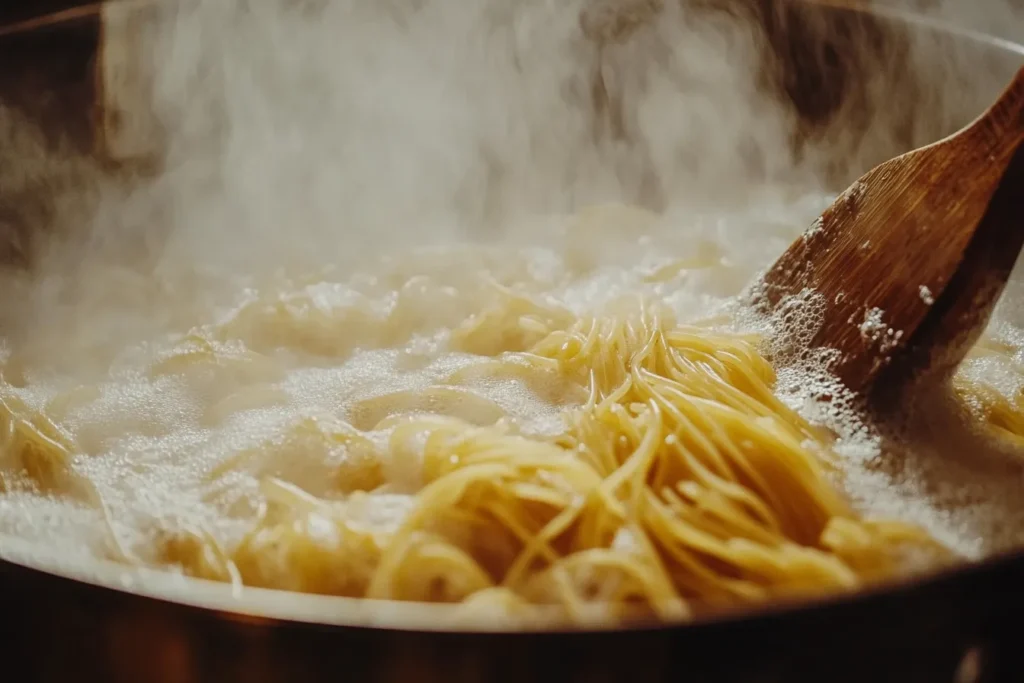
Getting spaghetti just right is key to making the dish unforgettable. Here’s how:
- Use Plenty of Water: A large pot with at least 4-5 quarts of water ensures the pasta doesn’t clump.
- Add Salt: Salted water enhances the pasta’s natural flavor. Add about 1-2 tablespoons once the water starts boiling.
- Stir Occasionally: This prevents sticking and ensures even cooking.
- Cook Al Dente: Check the package instructions but taste a strand 1-2 minutes before the recommended time. The pasta should be firm but not hard.
- Save Pasta Water: Before draining, save ½ cup of pasta water—it’s liquid gold for improving sauce texture!
Draining and Tossing Pasta for Maximum Flavor Absorption
Now that your spaghetti is perfectly cooked, the next step is crucial—combining it with the sauce.
- Never Rinse the Pasta: Rinsing removes the starch that helps the sauce cling to the noodles.
- Toss with Sauce Immediately: Instead of just spooning sauce on top, mix the pasta into the sauce while still hot.
- Use Pasta Water If Needed: If the sauce is too thick, a splash of pasta water helps loosen it and makes it stick to the spaghetti.
This method ensures every bite is infused with the rich, savory taste of your homemade tomato sauce.
Combining Spaghetti with Homemade Tomato Sauce
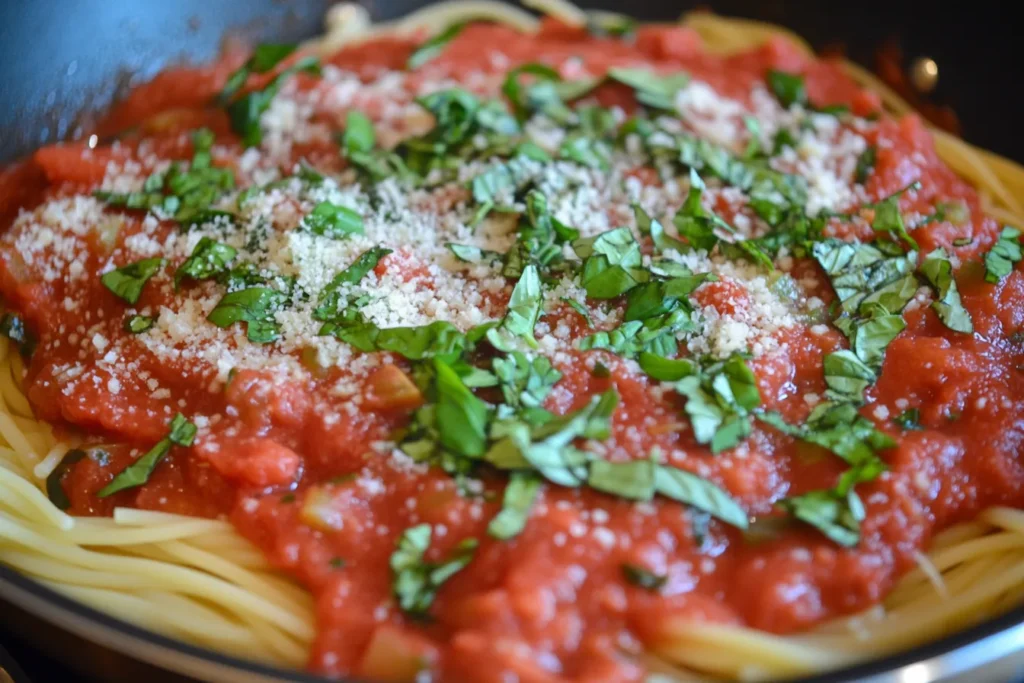
The Best Way to Mix Pasta and Sauce
A common mistake people make is plating spaghetti first and then pouring sauce over it. Instead, follow this simple technique:
- Add the Pasta to the Sauce Pan: Right after draining, transfer the spaghetti straight into the pan with your homemade sauce.
- Toss to Coat: Stir everything together over low heat for about a minute, ensuring the pasta is evenly coated.
- Adjust Consistency: If needed, add a splash of reserved pasta water to reach the perfect texture.
This approach allows the flavors to meld together, making your spaghetti with homemade tomato taste even better!
Adding Parmesan and Basil for Extra Flavor
Once your pasta is perfectly mixed, it’s time for the finishing touches:
- Freshly Grated Parmesan: Skip the pre-shredded kind—fresh Parmesan melts beautifully into the sauce.
- Fresh Basil Leaves: Tear basil with your hands (not a knife) to release its aroma without bruising.
- A Drizzle of Olive Oil: A touch of extra virgin olive oil enhances flavor and adds a silky finish.
Common Mistakes to Avoid
Even the simplest dishes can go wrong if you’re not careful. Here are a few mistakes to watch out for:
❌ Overcooking the Pasta: Spaghetti should be al dente—too soft, and it turns mushy.
❌ Using Too Much Sauce: The pasta should be coated, not drowning. Balance is key!
❌ Skipping the Pasta Water: A little starchy water helps the sauce stick and makes a world of difference.
❌ Serving It Cold: Spaghetti is best eaten immediately while warm and fresh.
By following these steps, you’ll master the art of making authentic spaghetti with homemade tomato sauce like a pro! 🍝
Want More Tasty Recipes?
If you love this dish, be sure to explore other delicious recipes at Daily Dish Diary for more meal ideas!
Variations and Additions to Enhance the Dish
Adding Protein: Meatballs, Chicken, or Shrimp
While spaghetti with homemade tomato sauce is delicious on its own, adding protein makes it even heartier. Here are some great options:
- Classic Meatballs: Juicy, well-seasoned meatballs are the perfect traditional pairing. Cook them separately and let them simmer in the sauce for extra flavor.
- Grilled Chicken: Sliced grilled chicken breast adds a lean, protein-packed twist. Season it with garlic, Italian herbs, and a touch of olive oil.
- Shrimp: Want a seafood spin? Toss in sautéed shrimp with garlic and red pepper flakes for a fresh, Mediterranean-style dish.
Vegetarian and Vegan Alternatives
If you prefer a meat-free version, don’t worry—there are plenty of plant-based ways to add richness to your homemade tomato pasta.
- Mushrooms: Sautéed mushrooms bring a meaty texture and umami flavor.
- Lentils or Chickpeas: These add protein and a satisfying bite without overpowering the sauce.
- Vegan Meat Substitutes: Plant-based meatballs or crumbled tofu work surprisingly well!
For a completely vegan sauce, skip the Parmesan and finish with nutritional yeast for a cheesy flavor.
Making It Spicy: Chili Flakes and Other Seasonings
If you love a little heat, there are plenty of ways to spice up your spaghetti with homemade tomato sauce:
- Red Pepper Flakes: A pinch adds a gentle kick without overpowering the dish.
- Fresh or Dried Chili Peppers: Finely chopped chili adds a bold, fiery touch.
- Spicy Italian Sausage: If you’re adding protein, opt for spicy sausage to infuse the sauce with heat.
Balancing spice with sweetness (like roasted bell peppers or caramelized onions) keeps the flavors well-rounded.
Serving and Presentation Tips
Best Side Dishes to Serve with Spaghetti
A great pasta dish deserves the perfect side. Here are some tasty options to complete your meal:
- Garlic Bread: Buttery, crispy, and packed with garlic, it’s the ultimate pairing.
- Fresh Green Salad: A light salad with balsamic dressing balances the richness of the pasta.
- Roasted Vegetables: Try zucchini, bell peppers, or eggplant for a colorful and healthy side.
Want more side dish ideas? Check out this Frozen Garlic Bread Guide for tips on making the perfect crunchy, flavorful bread to pair with your pasta.
Plating Like a Pro: Aesthetic Presentation Tips
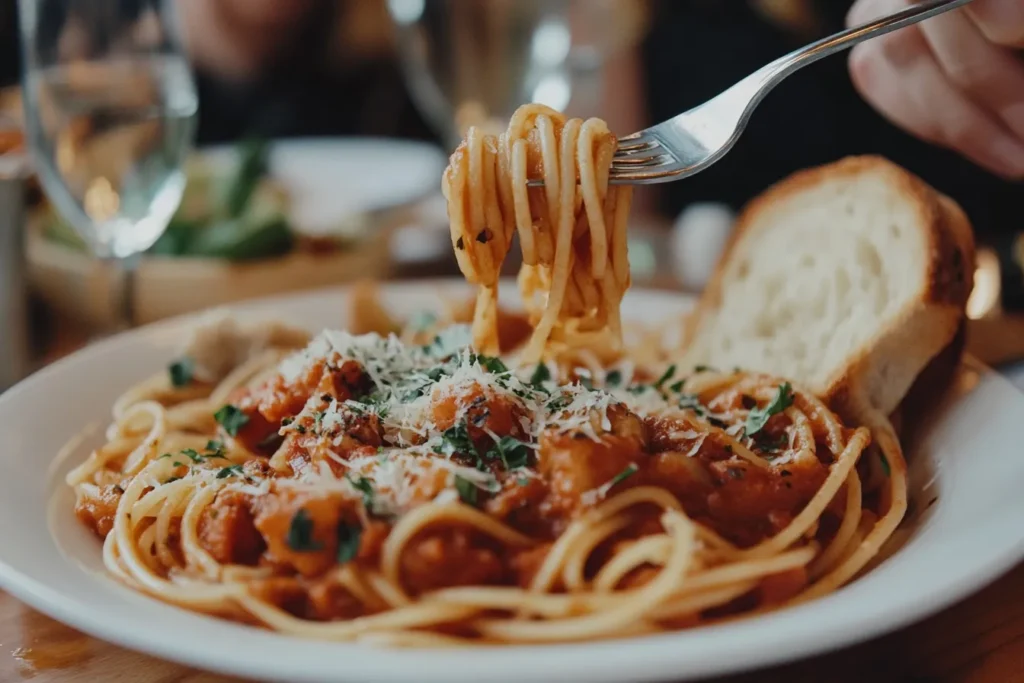
They say we eat with our eyes first, so here’s how to make your dish look as good as it tastes:
- Twirl the Pasta: Use tongs to create a neat, restaurant-style pasta nest.
- Garnish Strategically: Sprinkle fresh basil, Parmesan, or a drizzle of olive oil for extra appeal.
- Use a Wide Bowl or Plate: A shallow dish helps showcase the sauce and toppings beautifully.
Storing and Reheating Leftovers
Got leftovers? No problem! Here’s how to store and reheat your spaghetti with homemade tomato without losing flavor:
- Refrigeration: Store in an airtight container for up to 4 days.
- Freezing: Freeze the sauce separately for up to 3 months. For best results, avoid freezing the pasta itself.
- Reheating: Warm the sauce on low heat, adding a little water if it thickens too much. Reheat pasta separately or toss it directly into the sauce.
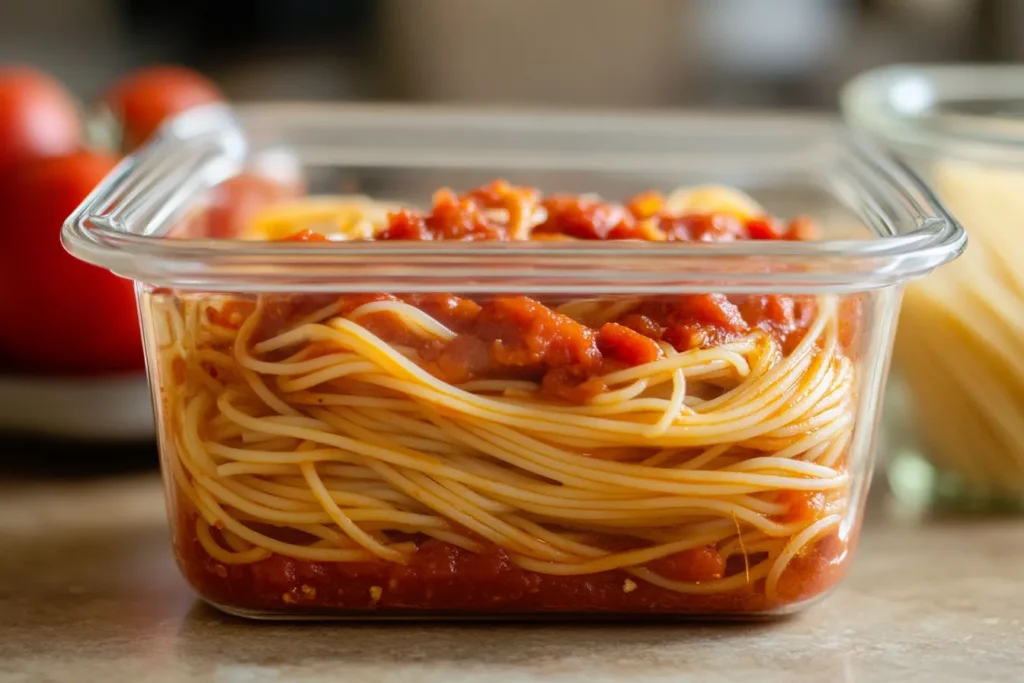
FAQs – Answering Common Questions
How to prepare spaghetti with fresh tomatoes?
Making spaghetti with homemade tomato sauce using fresh tomatoes is simple and rewarding. Follow these steps for the best results:
1-Choose ripe tomatoes – Roma or San Marzano varieties work best.
2-Blanch and peel – Boil tomatoes for 30 seconds, then transfer them to an ice bath. The skins will slide right off.
3-Chop and cook – Sauté garlic and onions in olive oil, then add chopped tomatoes and seasonings.
4-Simmer and blend – Cook on low heat for 30–40 minutes, then blend if you prefer a smoother sauce.
5-Combine with pasta – Toss your cooked spaghetti into the sauce, mix well, and enjoy!
What is the secret to a rich homemade tomato sauce?
The key to an unforgettable homemade tomato pasta sauce lies in slow cooking and quality ingredients. Here’s what makes a difference:
– Slow simmering: Cooking your sauce for at least 30–60 minutes deepens the flavor.
– Olive oil and garlic: A generous amount of high-quality olive oil enhances richness.
– Tomato paste: Adding a tablespoon of tomato paste boosts umami and thickness.
– Parmesan rind: Simmering a cheese rind in the sauce adds a deep, savory taste.
– Balancing acidity: If your sauce is too tangy, a pinch of sugar or a splash of balsamic vinegar smooths it out.
Can I make tomato sauce ahead of time?
Absolutely! Making homemade tomato sauce in advance saves time and enhances the flavor. Here’s how:
– Refrigerate: Store in an airtight container for up to 4 days.
– Freeze: Freeze in portions for up to 3 months. Thaw overnight in the fridge before reheating.
– Reheat properly: Warm on low heat, stirring occasionally. Add a little water if the sauce thickens too much.
What type of spaghetti is best for tomato sauce?
Classic spaghetti is a great choice, but other pasta types can work well too:
– Thin Spaghetti (Angel Hair): Best for a light, quick-cooking tomato sauce.
– Regular Spaghetti: The perfect balance of texture and sauce absorption.
– Whole Wheat or Gluten-Free Pasta: Great for a healthier twist.
– Linguine or Bucatini: Slightly thicker options for heartier sauces.
For the best texture, always cook pasta al dente and toss it with the sauce right before serving!
Final Thoughts on Spaghetti with Homemade Tomato
Mastering spaghetti with homemade tomato sauce is all about using fresh ingredients, cooking with care, and balancing flavors. Whether you love a simple classic version or enjoy experimenting with add-ins like meat, seafood, or spice, this dish is incredibly versatile.
By following the steps in this guide, you’ll create a pasta dish that’s bursting with flavor, beautifully textured, and perfect for any occasion. Plus, since homemade tomato sauce can be made ahead, it’s a great meal-prep option for busy days.
Now, it’s your turn to bring this Italian favorite to life in your own kitchen. So, grab those tomatoes, get that pasta boiling, and enjoy every bite of your delicious homemade spaghetti with tomato sauce! 🍝😋
Print
Spaghetti with Homemade Tomato
- Total Time: 1 hour
- Yield: 4 1x
Description
A classic Italian pasta dish featuring homemade tomato sauce made with fresh tomatoes, garlic, and herbs, served over perfectly cooked spaghetti.
Ingredients
For the Tomato Sauce:
- 2 lbs fresh Roma or San Marzano tomatoes (or canned)
- 3 tbsp extra virgin olive oil
- 3 cloves garlic, minced
- 1 small onion, finely chopped
- 1 tsp dried oregano
- ½ tsp red pepper flakes (optional)
- 1 tsp salt (adjust to taste)
- ½ tsp black pepper
- 1 tbsp tomato paste (for depth of flavor)
- ½ tsp sugar (optional, to balance acidity)
- ¼ cup fresh basil, chopped
- ½ cup reserved pasta water (for sauce consistency)
For the Pasta:
- 12 oz spaghetti
- 1 tbsp salt (for boiling water)
For Garnishing:
- Fresh basil leaves
- Grated Parmesan cheese
- Extra virgin olive oil (for drizzling)
Instructions
Step 1: Prepare the Tomatoes
- If using fresh tomatoes, blanch them in boiling water for 30 seconds, then transfer to an ice bath. Peel and chop them.
Step 2: Make the Sauce
- Heat olive oil in a pan over medium heat. Add garlic and onion, sauté until soft.
- Stir in tomato paste, oregano, red pepper flakes, and fresh tomatoes. Cook for 5 minutes.
- Reduce heat to low, cover, and simmer for 30-40 minutes. Stir occasionally.
- Add fresh basil, adjust seasoning, and remove from heat.
Step 3: Cook the Spaghetti
- In a large pot, bring water to a rolling boil. Add salt.
- Cook spaghetti according to package instructions until al dente (firm to the bite).
- Reserve ½ cup pasta water before draining.
Step 4: Combine Pasta and Sauce
- Transfer drained spaghetti into the pan with sauce. Toss well.
- Add a splash of reserved pasta water to adjust consistency.
Step 5: Serve and Garnish
- Divide pasta among plates. Top with grated Parmesan and fresh basil.
- Drizzle with olive oil and serve immediately.
Notes
- For a chunkier sauce: Skip blending the tomatoes.
- For a smoother sauce: Blend the cooked tomatoes before adding basil.
- For extra depth: Simmer with a Parmesan rind or a splash of balsamic vinegar.
- Prep Time: 15minutes
- Cook Time: 45minutes
- Category: Dinner
- Cuisine: Italian
Nutrition
- Calories: 450 kcal
- Sugar: 8g
- Fat: 14g
- Carbohydrates: 65g
- Fiber: 6g
- Protein: 12g
Keywords: spaghetti with homemade tomato, homemade spaghetti sauce, fresh tomato pasta, Italian pasta recipe, easy tomato sauce

